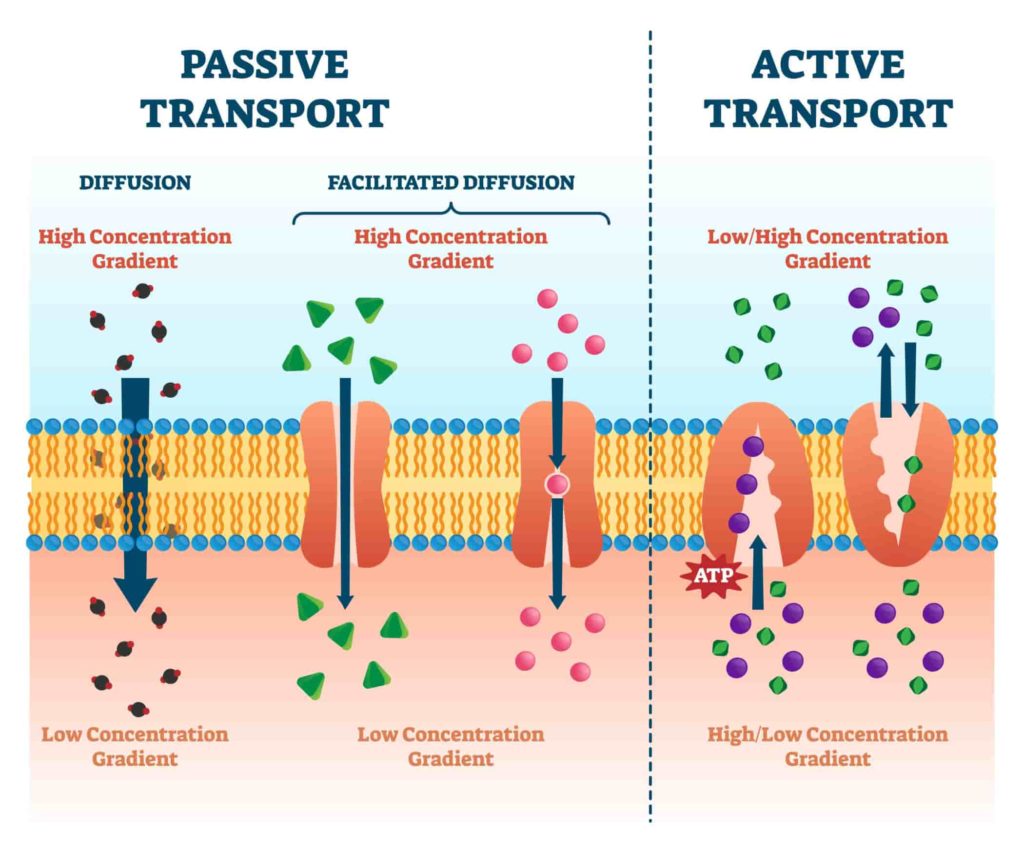Understanding The Different Types of Cellular Transport

Cells need to be able to move substances in and out of their boundaries. This is called cellular transport, and it’s one of the most important functions of living cells. As a result, cells have evolved many different ways to perform this function—different types of cellular transport exist within each type of cell. Here we’ll discuss some common types: active transport, passive transport, osmosis, facilitated diffusion, and vesicle transport.
Active Transport
Active transport is a method of transporting substances across a membrane against their concentration gradient. Active transport requires energy, which is provided by ATP. The strength and speed of active transport is proportional to the concentration gradient being crossed so that high concentrations exert stronger forces on the molecules being transported than low concentrations do. Active transport involves the use of proteins called pumps or carriers (depending on what exactly they carry). One example of active transport is the sodium-potassium pump in animal cells, which moves sodium ions out of cells and potassium ions into them.
Passive Transport
Passive transport is the movement of substances through a cell without the use of energy. It is one of two types of cellular transport, along with active transport. Passive transport does not require energy because it does not involve any active process within the cell.
Passive transport occurs in two ways: simple diffusion and facilitated diffusion. Simple diffusion occurs when a substance moves from an area where it’s higher concentration to an area where it’s lower concentration. This movement happens naturally due to differences in concentrations between areas, though no energy is required. Facilitated diffusion involves proteins that help move substances across membranes more efficiently than simple diffusion would allow. This type of passive transport requires energy but is still considered passive because it doesn’t require active processes within the cell itself.
Osmosis
Osmosis is the process by which water moves through a semi-permeable membrane from an area of higher concentration to an area of lower concentration. In osmosis, the water molecules move down a concentration gradient. This occurs especially in plant cells, where water flows into the plant through osmosis. The cell membrane will allow small molecules like oxygen and carbon dioxide to pass through it but not larger substances such as sugar or salt, which would damage the cell if they were allowed inside it.
Facilitated Diffusion
The second group of mechanisms is facilitated diffusion, which uses a carrier molecule to transport substances across the membrane. In this case, the substance moves down its concentration gradient, but with help from a transporter molecule that binds to it and carries it across the membrane.
As an example of facilitated diffusion, consider glucose within a cell: it has a higher concentration outside the cell than inside. But because it can’t pass directly through lipid bilayers, glucose needs to use special carrier proteins called GLUT transporters that act as “doors” into our cells.
Facilitated diffusion has several advantages over other types of cellular transport:
- It requires less energy than active transport or endocytosis because it does not require ATP for its operation (the energy comes from moving down an electrochemical gradient). This makes facilitated diffusion relatively easy on your body—in fact, many of your organs rely heavily on this type of process to keep working properly!
- Some viruses (such as HIV) can also use facilitated diffusion to infect cells to reproduce themselves. However, this type of infection usually results in disease, rather than helpful outcomes like those seen during nutrient absorption.
Vesicle Transport
Vesicle transport is the movement of small packets of fluid (vesicles) through your cell. Vesicles are created by the cell membrane and then filled with water, dissolved gases, or other substances before being transported from one part of the cell to another. The movement of vesicles is powered by ATP (adenosine triphosphate).
Cells need to perform cellular transport to survive.
Cellular transport is one of the most important cellular processes, and cells must perform it to survive. Without this process, nutrients would not enter or leave a cell. Waste could not leave, and information could not move into or out of a cell for protein synthesis or DNA replication.
Without cellular transport:
- Food would not be able to enter your body’s cells.
- Waste products would build up inside your body’s cells and eventually kill you.
- Information from DNA strands (genes) could not be put together into proteins that are essential for life to exist in humans, animals, and plants.4
In summary, while there are several types of cellular transport, they all serve a similar purpose: to move molecules around within cells. Cellular transport is the process that allows cells to move nutrients, hormones, and other molecules into and out of them.
Cells need to perform transport to survive and function. Without cellular transport, you would not be able to move food through your digestive system or oxygen into your lungs. There are several types of cellular transport, each with a specific role. To learn more about cellular transport, and MGMR technology, feel free to check out our blog or contact BioPact.